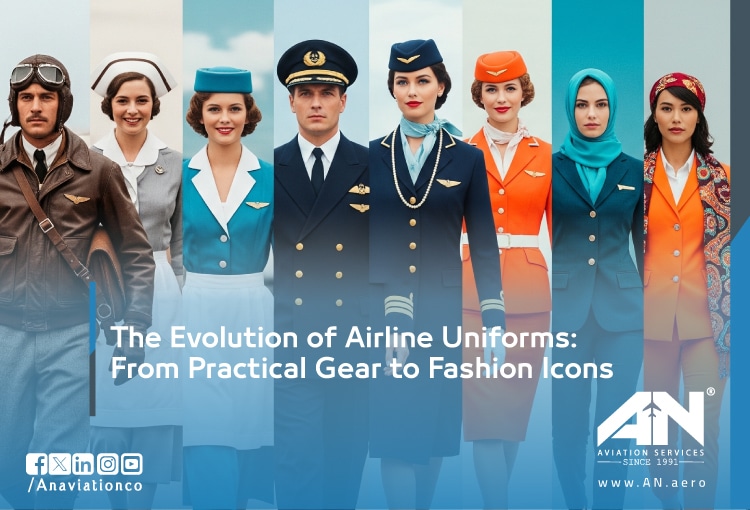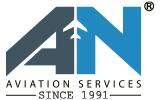
Airline uniforms have always been more than just clothes. They’ve told stories. They’ve shown rank, reflected pride, and kept people safe. But did they always look this sharp? No. It all started with a pure function first.
Let’s break it down and see how the airline uniform went from practical to powerful and sometimes even fashion-forward.
Early Aviation Attire (1920s–1940s)
In the early decades of aviation, most pilots were former military personnel or worked closely with the armed forces, so their attire naturally reflected military fashion. Leather flight jackets, tall boots, wool trousers, and caps were common, designed for functionality, protection from the cold in open cockpits, and a commanding, authoritative look.
Stewardess Outfits Practicality Over Style:
In the 1930s and early 1940s, stewardesses (the term used before “flight attendant” became standard) wore uniforms focused more on utility than glamour. Early outfits resembled nurse uniforms, modest dresses, or skirt suits, sensible shoes, and caps, emphasizing hygiene, approachability, and professionalism. Their primary role was to assist passengers and manage in-flight safety, not to present a fashion statement.
Practical, Protective Gear for pilots:
Since aircraft cockpits were often open or poorly insulated, pilots wore heavy leather coats, scarves, goggles, and gloves to combat wind chill and debris. Flight suits were typically made of wool or leather, chosen for warmth and durability at high altitudes.
Functional Beginnings (1950s–1970s)
Following World War II, the aviation industry experienced rapid growth and a surge in public interest. As commercial air travel expanded, airline uniforms evolved to reflect a greater sense of professionalism, safety, and brand identity. Uniforms during this period prioritized practicality, discipline, and structure, key elements that helped build passenger trust.
Post-War Professionalism:
In the post-war era, airlines sought to present their flight crews as authoritative and dependable. This led to the adoption of uniform styles heavily influenced by military aesthetics. The goal was to establish a visual standard that communicated order, discipline, and responsibility qualities essential to air travel.
Structured Suits for Pilots:
Pilot uniforms shifted from the rugged, functional attire of the early aviation years to formal suits that closely resembled naval officers’ uniforms. These included double-breasted jackets, epaulettes, gold sleeve stripes, and peaked caps. Each element served a purpose: the epaulettes and stripes denoted rank, while the overall design conveyed leadership and technical competence. This standardized appearance contributed to a cohesive image of professionalism across global carriers.
Nurse-Inspired Cabin Crew Attire:
During this same period, the appearance of female cabin crew, often referred to as stewardesses, was shaped by the fact that many were originally qualified nurses. Their uniforms reflected this medical background, with modest designs featuring tailored skirts, blouses, caps, and matching accessories. The intent was to portray warmth, capability, and attentiveness, reassuring passengers that trained professionals were onboard to support both comfort and safety.
Airlines also maintained strict grooming and presentation guidelines, reinforcing a uniform brand image and consistent service standard.
Material Choices & Practical Features:
As the aviation industry matured, the demands placed on airline uniforms increased. Crew members needed garments that could withstand long hours, varied climates, and frequent cleaning, all while maintaining a polished appearance.
Wool & Polyester for Durability:
Initially, wool was favored for its strength, warmth, and wrinkle resistance. It was well-suited for long-haul flights and varied temperatures. As technology advanced, polyester emerged as a preferred alternative due to its lighter weight, cost-efficiency, and durability. Polyester also offered ease of maintenance and was ideal for large-scale uniform production, making it widely adopted by airlines worldwide.
Hidden Pockets for Essential Tools:
Uniforms during this time were not only designed for appearance but also equipped with functional elements to support operational efficiency. Hidden pockets became a common feature, enabling cabin crew to carry essential tools such as pens, notepads, safety cards, and communication devices discreetly. These design features helped ensure smooth onboard operations and reinforced the image of a well-prepared and organized crew.
The Jet Age Transformation (1980s–2000s)
The final decades of the 20th century marked a significant shift in how airlines approached uniform design. As air travel became more global and competitive, branding grew increasingly important, and uniforms evolved into key elements of airline identity. This period saw a stronger emphasis on aesthetics, fashion, and cultural alignment without compromising professionalism.
Airlines Embrace Fashion:
During the Jet Age, airlines began to view uniforms not only as functional workwear but also as brand ambassadors. Cabin crew uniforms became a visual representation of an airline’s personality, values, and level of service. The goal was to stand out in a rapidly growing industry and leave a lasting impression on passengers from the moment they stepped onboard.
1- Designer Collaborations (YSL, Armani)
To achieve more refined and distinctive looks, several airlines partnered with internationally renowned fashion designers. These collaborations elevated uniform design to the standards of haute couture. Examples include:
- Air France is working with Yves Saint Laurent, introducing elegance through structured silhouettes and refined detailing.
- Alitalia is collaborating with Giorgio Armani, who brought his signature sophistication and tailored Italian style to cabin crew uniforms.
Such partnerships blended style with function and positioned airlines as modern, forward-thinking brands with a commitment to quality.
2- Cultural Influences in Middle Eastern Carriers
As carriers from the Middle East expanded their global reach, they incorporated cultural elements into their uniforms to reflect heritage and national identity. Airlines such as Emirates, Etihad Airways, and Qatar Airways introduced attire that combined modesty with elegance, often including headscarves, long hemlines, and neutral tones accented with gold or burgundy.
These designs not only respected local customs but also reinforced each airline’s cultural narrative on a global platform.
Gender Norms Evolve:
Social change during this era also influenced uniform standards. Traditional gender roles began to shift, and airlines adapted by offering more inclusive, comfortable, and practical options.
1. Pantsuits Replace Dresses
Many airlines introduced pantsuits for female crew members as an alternative to skirts and dresses. This change reflected broader shifts in workplace fashion and supported greater functionality, especially on longer or international routes. Pantsuits allowed for improved mobility and were often viewed as more modern and empowering.
2. Male Flight Attendants Break Stereotypes
During this period, the presence of male cabin crew became more common, challenging outdated perceptions that flight attendant roles were exclusive to women. Uniform policies evolved to reflect gender neutrality, offering consistent designs for all staff while accommodating variations in cut and fit.
This development signaled a growing commitment to diversity and equality within the aviation industry, both in employment and presentation.
Modern Uniform Innovations (2010s–Present)
In recent years, airline uniforms have evolved to meet modern demands balancing advanced technology, environmental responsibility, and cultural inclusivity. Airlines now view uniforms as strategic tools that reflect operational efficiency, employee comfort, and corporate values. The focus has shifted toward innovation, functionality, and sustainability, with design choices driven by both aesthetics and purpose.
High-Tech Fabrics:
The integration of technical textiles has transformed the performance of airline uniforms. Modern fabrics now offer enhanced comfort, safety, and durability meeting the physical demands of airline staff while maintaining a refined appearance.
Flame-Resistant Materials:
For safety-critical roles, especially in aviation, flame resistance is non-negotiable. Many airlines have adopted flame-retardant fabrics in pilot and cabin crew uniforms, ensuring compliance with international safety standards and providing critical protection in emergency situations.
Moisture-Wicking & Stretch Technology:
Comfort is a top priority for crew members who work long shifts in varied climates. Uniforms now feature moisture-wicking and stretchable fabrics that allow breathability and freedom of movement. These materials help regulate body temperature, reduce fatigue, and maintain a professional look throughout the day.
Sustainability Trends
Environmental concerns have influenced every aspect of airline operations including uniforms. Airlines are increasingly prioritizing sustainability in uniform production, aiming to reduce their carbon footprint and align with global climate goals.
Recycled Materials in Uniform Production:
Several airlines have begun incorporating recycled polyester and eco-friendly fabrics into their uniforms. These materials often come from repurposed plastic bottles or post-consumer waste, supporting waste reduction efforts while delivering the same performance as traditional textiles.
Longevity Over Frequent Redesigns:
Rather than introducing entirely new uniform collections every few years, many airlines now opt for longer-lasting designs. Uniforms are engineered for durability, with timeless aesthetics that reduce the need for frequent replacements. This approach supports cost-efficiency and minimizes textile waste.
Iconic Uniform Case Studies:
Some airline uniforms have become globally recognized symbols reflecting brand identity, national pride, and innovative design.
- Singapore Airlines: The Sarong Kebaya, designed by Pierre Balmain, blends traditional Southeast Asian fashion with elegant tailoring. It remains largely unchanged since the 1970s, symbolizing grace and cultural heritage.
- Virgin Atlantic: Known for its bold approach, Virgin Atlantic introduced the red power suit created by Vivienne Westwood. This uniform combined eco-conscious materials with sharp, contemporary styling.
- Emirates: Emirates’ uniforms balance traditional Middle Eastern aesthetics with modern cuts, including the recognizable red hat and veil, representing both cultural respect and premium service standards.
The Future of Airline Attire
Looking ahead, uniform design is expected to incorporate smart technologies and further adapt to social and operational needs.
1- Smart Uniform Concepts: Research is ongoing into biometric-integrated clothing capable of monitoring crew health indicators such as heart rate, fatigue levels, and posture. These innovations aim to improve crew well-being and onboard performance.
2- Self-Cleaning Fabrics: Another advancement under development is self-cleaning textiles that use nanotechnology to repel liquids, resist odors, and prevent bacterial growth. These fabrics could significantly reduce laundering frequency, improve hygiene, and lower maintenance costs.
Cultural Representation
As airlines serve increasingly diverse customer bases, uniforms must reflect respect for local traditions and personal identities.
1. Local Heritage in Design: More carriers are incorporating regional patterns, colors, and symbols into their uniforms to celebrate national culture while maintaining a cohesive corporate look.
2. Inclusive Sizing & Modest Options: Uniform programs now include inclusive sizing, gender-neutral cuts, and modest alternatives. This ensures that all staff, regardless of body type, gender identity, or cultural background, can wear uniforms that are both comfortable and respectful of their values.
Uniform Procurement for Charter Operators
Even in the charter sector, uniform design must align with both safety regulations and branding. Charter operators often invest in custom-designed, safety-compliant uniforms that balance practicality with aesthetics, ensuring crew professionalism across a wide range of missions.
This modern era of airline uniforms represents a clear shift: from standardization to customization, from aesthetics alone to function, safety, sustainability, and cultural awareness. As aviation continues to evolve, so too will the uniforms meet new expectations while maintaining the timeless goal of presenting aircrews as capable, trustworthy, and globally connected professionals.

